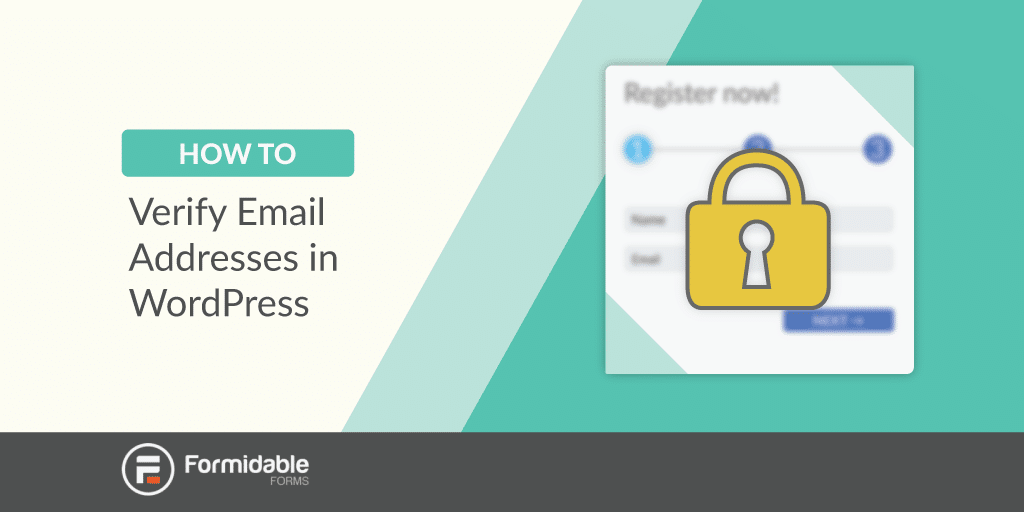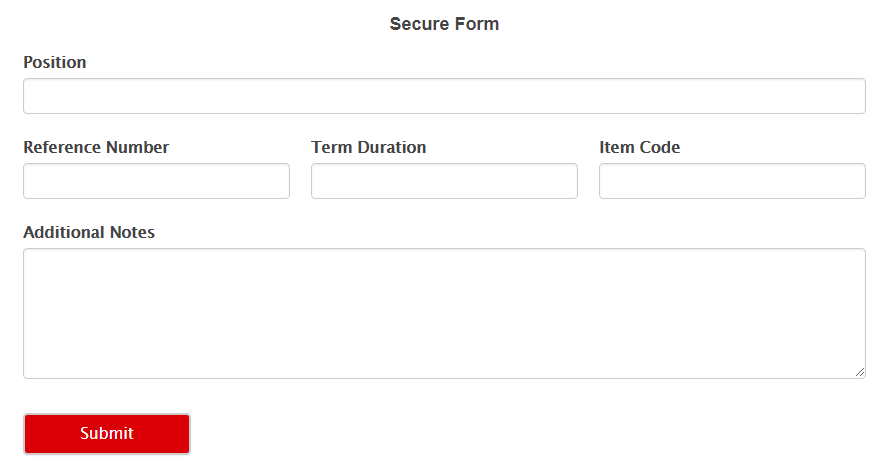Do you want to use WordPress to verify email addresses before submitting a form? Do you want email verification without user registration?

Approximate read time: 5 minutes
Sometimes, you don't want to invite everyone to the party. One way to ensure that only verified users can see a form is to use WordPress to verify email registration to unlock access to forms.
This isn't something you'd do to all your contact forms, but if you want users to register for an invite-only event, you'd need to make sure that only the invited users can access your registration form.
In many cases, it is essential to ensure form submissions come from legitimate users.
Email verification can be triggered automatically when a new user is registered on your WordPress site. If you create user accounts with your WordPress forms, you can block other forms from logged-out users. Quick and simple, no passwords necessary.
In this quick guide, we'll show you how to verify email addresses in WordPress to ensure only valid form entries. Once the setup is complete, you'll have a form that users can only complete after verifying an email in WordPress.
Let's dive in!
Read more: 7 Best Wordpress Email Marketing Plugins
Verify email address without registration
Although this isn't a built-in feature in Formidable Forms, our WordPress form builder is quite dynamic. With a few tweaks, you can verify user email addresses in any WordPress form you choose! It's like having two-factor authentication (2FA) without an external verification plugin.
If you aren't already a Formidable user, you'll be amazed by its powerful WordPress forms features. To fully implement this feature, you'll need Formidable Pro.
If you haven't settled on a complete form-building solution for your WordPress website, now is the time! We offer a 14-day money-back guarantee. In theory, you could try Formidable, follow this guide, and get your money back immediately if you don't like the results.
...no questions asked!
Here are the basic steps we'll take in this how-to guide:

Step 1: Create the email verification form
First, create a form to request the user's email address for user verification. This form can be short and sweet, without extra details, and acts as the verification screen. Our form asks for an email address with a confirmation field. That's it.

This initial form displays a success message to instruct the user to check their inbox and confirm the email address.
Step 2: Use a View to hide form B (unless the user verified their email)
Form B should only be visible to users who have verified their email addresses via Form A. To achieve this, place the shortcode for form B inside a View. Use filtering to hide it from non-verified user roles.
- Set the View to show a "Single Entry" from Form A.
- I'll keep it simple, with only the shortcode for Form B in the Content box.
- Add two filters so the View Content (Form B) will only be visible if both the Entry Key and Email Address match an entry in Form A. Add default=1 to the filters so if the URL is changed, it doesn't ignore the filter.

If the page is loaded directly without clicking on the link in the email, these filters will return "No Entries" and hide the form instead of an error message. Combining the random (and not publicly visible) entry key with the email address greatly increases the security of this system.
Modify the default "No Entries" message to include the shortcode for Form A or a link. This tells visitors who may arrive at the verification page to confirm their email address before proceeding.

Step 3: Add a verification link in the email message
WordPress email confirmation is triggered when a user submits an email address using Form A. The email must contain a link to the View created in step 2.
We'll create this link using the guide to create a custom search. Pass the entry key and email address to match the filters in the View. If you add matching filters in the view, you can use any form values you'd like.

When the link in the verification email is clicked, the View matches the data in the URL to an entry in Form A. When it finds a match, the form is visible!

So that's it! There are three simple steps to create a form that users can only complete after email verification. Have you used similar methods to verify users who aren't logged in? Let us know in the comments below.
Keep it locked to the Formidable blog for more WordPress tips, guides, and how-to's. Also, join our community on Facebook, Twitter, and YouTube for more WordPress email tips and tricks!
 How to Schedule Email Autoresponders in WordPress [No Code!]
How to Schedule Email Autoresponders in WordPress [No Code!] How To Use WP Mail SMTP with the WP Mail SMTP Plugin [Guide]
How To Use WP Mail SMTP with the WP Mail SMTP Plugin [Guide] How to Change the Email Address in a WordPress Contact Form
How to Change the Email Address in a WordPress Contact Form How To Send a WordPress Email Confirmation [Only 2 Steps!]
How To Send a WordPress Email Confirmation [Only 2 Steps!] WordPress Not Sending Emails? Here’s How To Fix It!
WordPress Not Sending Emails? Here’s How To Fix It! 3 Email Personalization Examples To Maximize User Engagement
3 Email Personalization Examples To Maximize User Engagement How To Create a Mailgun Subscribe Form in WordPress
How To Create a Mailgun Subscribe Form in WordPress How to Create Holiday Out of Office Messages for WordPress Forms
How to Create Holiday Out of Office Messages for WordPress Forms 10 Best WordPress Email Marketing Plugins [Free & Paid!]
10 Best WordPress Email Marketing Plugins [Free & Paid!] How to Reduce Email Unsubscribe Rates: 8 Tips
How to Reduce Email Unsubscribe Rates: 8 Tips 7 Content Upgrade Examples that will Boost Email Signups
7 Content Upgrade Examples that will Boost Email Signups How to Create a Winning Email Strategy for Your WordPress Blog
How to Create a Winning Email Strategy for Your WordPress Blog How to Create an Email List for Your WordPress Blog
How to Create an Email List for Your WordPress Blog Why You Should Replace HTML Email Links with Email Contact Forms
Why You Should Replace HTML Email Links with Email Contact Forms How to Send Emails to Dynamic Recipients from a WordPress Contact Form
How to Send Emails to Dynamic Recipients from a WordPress Contact Form
Can elaboarte the steps for creating verification link of Step 3 as custom search guide is bit confusing
Can you open a ticket in our helpdesk with this question please?
Hi Nathanael, thank you for sharing this. This helps a lot.
I do it without email-filter. I filter with entry-key and userID=current_user.
This also works fine.
I don't know how to do this.
Hi Wayne. Sorry you're having trouble with this. Can you please open a ticket so we can help you?
https://formidableformscom.bigscoots-staging.com/new-topic/
Hi,
which package version do I need to create this? The pro version you refer to in the post no longer exists.
Thanks.
Hi there,
You would need at the "Plus" license or higher to build this system since it requires Views to work.
Very superb info can be found on blog.
Can I use the same email verification form (Form A, in your blog) to verify emails for other forms (e.g. Form B, Form C, etc)? How would you do that so that you know what link to send in the email?
Hi there,
Could you please ask your question from our support page so our support team can assist you with this?
Nathanael, this is a nice blog about verifying email addresses on FormidableForms. However I would like to point out that this method may still not prevent disposable/temporary email addresses from getting through. I would recommend using Antideo Email Validator in addition to the email verification link for better email validation capabilities. The Antideo plugin is free and works out of the box with FormidableForms. Would be great if you can mention the plugin in you blog if possible, that would be very helpful to the blog visitors
The instructions are VERY unclear. Cannot understand anything:
1. What does "Set the View to show a "Single Entry" from Form A." mean? How do you do it?
2. "I'll keep it simple, with only the shortcode for Form B in the Content box." How do you do it?
3. "Add two filters so the View Content (Form B) " What does it mean? Where do you add filters? What are the params....
Very poor artcile!
Hi there, sorry you weren't able to follow this blog post to accomplish what you needed. We try to keep our blog posts fairly high-level and basic, but our documentation goes into details for each of the questions you asked. If you are having trouble, please contact us from our support page so our customer success team can help.
Hi, I want to use this feature for one site, which package on your pricing page is required for this feature to work? You say PRO, but your packages are not parked as pro, therefore I am unsure?
Hi Beven,
This would require a Plus level license or above to achieve since it uses our Views add-on.
The full documentation for this process is located at https://formidableformscom.bigscoots-staging.com/knowledgebase/advanced-view-concepts/#kb-show-form-based-on-another-form
Hope this helps!